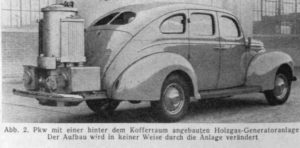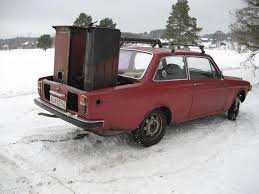For the past three weeks I’ve been talking about transportation in a post-apocalyptic (PA) world. Specifically, how unlikely it will be that the survivors will be using horses.
We’ve looked at the horse and found it wanting. A much more practical animal is the dog, and we might see the return of the dog cart and dog sled in a PA world.
Last week I looked at the steam automobile. The great advantage of steam cars is that anything that burns can be used for fuel to power the vehicle. Another significant advantage is that we know how to drive cars. We don’t know jack about horses.
Today, I want to look at wood gas. The advantage of using wood gas is that it doesn’t require any major modifications to the internal combustion engine. And like the steam car, a wide variety of “feeders” can be used to generate the gas; the one most used being wood.
So what is wood gasification? Basically, it is the process of cooking wood to produce a burnable gas.
Here is a link to a detailed manual on wood gas: http://www.gengas.nu/byggbes/contents.shtml Be sure to print out this manual. It will make a great addition to your survival library.
A wood gas generator turns carbon containing material into hydrogen and carbon monoxide, with possibly some methane in the mix. This “producer gas” or “syngas” can then be used to power cars, trucks, buses, and tractors.
Wikipedia has an excellent introductory article on wood gas: https://en.wikipedia.org/wiki/Wood_gas
This article at Make contains diagrams, and notes the pros and cons of using wood gas: https://makezine.com/2010/06/24/lost-knowledge-wood-gas-vehicles/
Here’s a how-to article on building a gasifier that outlines the problems a DIYer might encounter: https://www.instructables.com/A-Home-Built-Biomass-Gasifier-for-Producing-Wood-G/
The major problem as noted in the above article is the production of tar. Which probably would necessitate a tar scrubber in order to be able to use a wider range of less “fussy” biomass.
At the end of the day, even though the above DIYer encountered problems, the wood gasifier is established tech. These devices are currently in production in China and Russia. All one needs to do is to obtain one and essentially copy it to provide a wood gas culture here in the States and anywhere else where self-sufficiency is valued.
Like the steam-powered car, the “woodmobile” can be powered by any carbon containing material. In a post-apocalyptic world, such flexibility will be crucial to the survivors and will enable them to continue to use cars and trucks.
In addition, a wood gasifier can be used to fuel a cookstove or a furnace, or a gas-powered refrigerator, and even a gas lamp — and thus enable the PA survivors to enjoy a certain amount of pre-apocalyptic normalcy.
Europe survived on wood gas in World War II, and, as noted above, China and Russia still manufacture wood gasifiers for cars and industrial use.
In fact, wood gas is one way the world could free itself from petroleum. Because any carbon-based material, not just wood, can be used to produce gas. In fact, all manner of agricultural waste can be used to generate producer gas.
Here in the US, we have a tendency to make things complex and difficult. We spent millions developing a space pen. The Russians used a pencil.
The battery-powered electric car is another ridiculous example of making things complex. Instead of using established technology to solve the problems of fossil fuel use and pollution, we resort to solutions for which we don’t have the technology to make them feasible on a wide scale.
Battery technology is not sufficiently advanced for electric cars to be able to compete with the internal combustion engine. In addition, to the lengthy charge time, improper charging of the battery can shorten its lifespan.
Further more, batteries are toxic — both to manufacture and dispose of. And the last thing we need is more toxic manufacturing and waste in our environment. Batteries also use non-renewable resources in their manufacture. How wise is that?
On the other hand, wood gas makes use of established technology and contributes no waste to the environment and provides a much cleaner exhaust than gasoline or diesel. In fact, using wood scrap, agricultural waste, and waste biomass material, a wood gasifier actually saves the environment from being polluted.
Now advocates of electric cars will say that an electric car doesn’t pollute. And that is true. But the production of electricity for the power grid to charge the car does generate pollution. And let’s be honest with ourselves: the day when wind and solar will be able to supply all our power needs is way off in the distant future. We are going to be relying on fossil fuel for a very long time. But we can significantly reduce our dependence — with currently available technology.
The manufacture of batteries is highly polluting. And uses non-renewable resources. And their disposal adds to our toxic waste problem. Which makes batteries, in my opinion, a non-starter for mass transportation.
Let’s face facts: electric cars are polluters. The pollution is just being hidden from us, the potential consumer.
The electric car is not the answer. Which is why they went out of fashion back around World War I. By contrast, the steam car didn’t make it only because no one mass-produced them. Which made the price tag something only the rich could afford. (A Stanley steamer sold for $5000, while a Model T went for $500.)
Steam cars and gasoline cars powered by wood gasifiers are the real solution. They make use of established tech and could end our dependence on fossil fuel in a very short period of time.
In a post-apocalyptic world, there will be no re-charging stations, and no petroleum production or refining. But that doesn’t mean we have to do without cars and trucks, and try to recreate a horse culture, which would take hundreds of years to reproduce.
Wood gas is readily available and just might be what saves us and enables us to rebuild a better world.
Comments are always welcome. And until next time, happy reading!
 CW Hawes is a playwright, award-winning poet, and a fictioneer; as well as an armchair philosopher, political theorist, and social commentator. He loves a good cup of tea and agrees that everything’s better with pizza.
CW Hawes is a playwright, award-winning poet, and a fictioneer; as well as an armchair philosopher, political theorist, and social commentator. He loves a good cup of tea and agrees that everything’s better with pizza.




